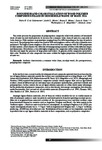Use este identificador para citar ou linkar para este item:
http://www.alice.cnptia.embrapa.br/alice/handle/doc/1039815Registro completo de metadados
| Campo DC | Valor | Idioma |
|---|---|---|
| dc.contributor.author | CADEMARTORI, P. H. G. de | pt_BR |
| dc.contributor.author | MISSIO, A. L. | pt_BR |
| dc.contributor.author | MATTOS, B. D. | pt_BR |
| dc.contributor.author | GATTO, D. A. | pt_BR |
| dc.contributor.author | MAGALHAES, W. L. E. | pt_BR |
| dc.contributor.author | LIMA, E. A. de | pt_BR |
| dc.date.accessioned | 2016-03-07T11:11:11Z | pt_BR |
| dc.date.available | 2016-03-07T11:11:11Z | pt_BR |
| dc.date.created | 2016-03-07 | pt_BR |
| dc.date.issued | 2015 | pt_BR |
| dc.identifier.citation | Maderas. Ciencia y Tecnología, Concepción, v. 17, n. 3, p. 457-468, Jul. 2015. | pt_BR |
| dc.identifier.uri | http://www.alice.cnptia.embrapa.br/alice/handle/doc/1039815 | pt_BR |
| dc.description | This study presents the preparation of polypropylene composites filled with mixtures of household waste of mate-tea and wood particles to increase the economic value chain of mate-tea, especially in Latin America. Filler mixtures in proportions ranging from 0 to 60% depending on the type of particle were used. The polypropylene matrix was fixed at 40% and roughness surface and color evaluation were performed. The highest mean roughness (Ra) was observed for the composite with 30:30% proportion of filler mixture, which denotes the difficulty of homogenizing a mixture of fillers with different shapes and dimensions. Nevertheless, even with higher roughness for composites with a balanced blend of filler, this does not imply the presence of large peaks and valleys. In general, all the composites presented a dark color. Variation of color composites was more evident for higher proportions of household waste of mate-tea. | pt_BR |
| dc.language.iso | eng | eng |
| dc.rights | openAccess | eng |
| dc.subject | Compósito polimérico | pt_BR |
| dc.subject | Erva mate | pt_BR |
| dc.subject | Resíduo doméstico | pt_BR |
| dc.subject | Característica estética | pt_BR |
| dc.subject | Aesthetic characteristics | pt_BR |
| dc.subject | Economic value chain | pt_BR |
| dc.subject | Eucalypt wood | pt_BR |
| dc.subject | Polypropylene composite | pt_BR |
| dc.title | Roughness and color evaluation of wood polymer composites filled by household waste of mate-tea. | pt_BR |
| dc.type | Artigo de periódico | pt_BR |
| dc.date.updated | 2016-03-07T11:11:11Z | pt_BR |
| dc.subject.thesagro | Eucalipto | pt_BR |
| dc.subject.thesagro | Ilex Paraguariensis | pt_BR |
| dc.subject.thesagro | Madeira | pt_BR |
| riaa.ainfo.id | 1039815 | pt_BR |
| riaa.ainfo.lastupdate | 2016-03-07 | pt_BR |
| dc.identifier.doi | http://dx.doi.org/10.4067/S0718-221X2015005000041 | pt_BR |
| dc.contributor.institution | Pedro H. G. de Cademartori, Pós-graduação da UFPR; André L. Missio, Pós-graduação da UFSM; Bruno D. Mattos, Pós-graduação da UFPR; Darci A. Gatto, UFPEL; WASHINGTON LUIZ ESTEVES MAGALHAES, CNPF; EDSON ALVES DE LIMA, CNPF. | pt_BR |
| Aparece nas coleções: | Artigo em periódico indexado (CNPF)  | |
Arquivos associados a este item:
| Arquivo | Descrição | Tamanho | Formato | |
|---|---|---|---|---|
| 2015WashingtonMCyTRoughness.pdf | 3,22 MB | Adobe PDF |  Visualizar/Abrir |









